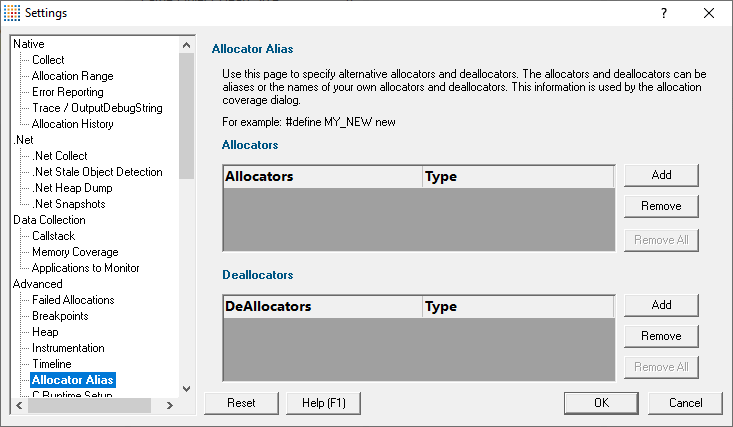The Allocator Alias tab allows you to specify any custom or in-house MACROs used to wrap C/C++ keywords and functions such as new, delete, malloc, realloc, free, etc.
This feature was added to improve source code parsing for the case when users have wrapped the keywords.
 The default behaviour is to have no aliases set, and if you don't wrap the C/C++ keywords in this way, you won't need to define any allocator aliases here.
The default behaviour is to have no aliases set, and if you don't wrap the C/C++ keywords in this way, you won't need to define any allocator aliases here.

The image above shows an example where MY_NEW, MY_NEW_ARRAY, MY_DELETE and MY_DELETE_ARRAY have been used to wrap the C/C++ keywords new, new [], delete and delete [].
 Note: when using allocator and deallocator alias macros, ensure that the macro and all arguments to the macro are on the same source code line. Macros that span lines will not be parsed correctly. This is because the current parser works a line at a time.
Note: when using allocator and deallocator alias macros, ensure that the macro and all arguments to the macro are on the same source code line. Macros that span lines will not be parsed correctly. This is because the current parser works a line at a time.
Allocators
To add a custom allocator, use the top table:
•Add  enter your custom macro name in the Allocators column
enter your custom macro name in the Allocators column  double click in the Type column
double click in the Type column  Choose the matching Allocator Type from the list
Choose the matching Allocator Type from the list
The allocator type can be one of the following:
•NEW - new() •NEW [ ] ARRAY - new [] •MALLOC - malloc() •CALLOC - calloc() •REALLOC - realloc() •EXPAND - _expand() •HEAP_ALLOC - HeapAlloc() •HEAP_REALLOC - HeapReAlloc() •GLOBAL_ALLOC - GlobalAlloc() •GLOBAL_REALLOC - GlobalReAlloc() •LOCAL_ALLOC - LocalAlloc() •LOCAL_REALLOC - LocalReAlloc() |
•VIRTUAL_ALLOC - VirtualAlloc() •VIRTUAL_REALLOC - VirtualReAlloc() •COTASKMEM_ALLOC - CoTaskMemAlloc() •COTASKMEM_REALLOC - CoTaskMemReAlloc() •SYS_ALLOC_STRING - SysAllocString() •SYS_ALLOC_STRING_BYTE_LEN - SysAllocStringByteLen() •SYS_ALLOC_STRING_LEN - SysAllocStringLen() •SYS_REALLOC_STRING - SysReallocString() •SYS_REALLOC_STRING_LEN - SysReallocString() •USER_ALLOC - see below •USER_REALLOC - see below •USER_ALLOC_ARG1...10 - see below |
USER_ALLOC - is a substitute for a user specified alloc where your macro simply replaces a keyword (such as new, malloc, etc)
USER_REALLOC - is for user specified realloc
USER_ALLOC_ARG1...10 - is for a user specified alloc where your macro takes arguments and one of the arguments 1...10 is the allocation. See the end of this topic for example code.
Deallocators
Managing deallocator alias works in the same was as allocators above, but via the lower table, with deallocator types being one of the following:
•DELETE - delete •DELETE [] ARRAY - delete [] •FREE - free() •HEAP_FREE - HeapFree() •GLOBAL_FREE - GlobalFree() •LOCAL_FREE - LocalFree() |
•VIRTUAL_FREE - VirtualFree() •COTASKMEM_FREE - CoTaskMemFree() •SYS_FREE_STRING - SysFreeString() •VARIANT_CLEAR - VarianctClear() •USER_FREE - user specified free |
Removing aliases
You can remove either selected alias or all aliases from each table
•Select one or more items in the list  Remove
Remove  removes all selected allocator aliases
removes all selected allocator aliases
•Remove All  removes all the allocators in the table
removes all the allocators in the table
Reset All - Resets all global settings but does not remove the allocator and deallocator aliases set on this page of the settings dialog.
Reset - Resets the settings on the current page.
Example use of the USER_ALLOC_ARG1...10 allocator alias
For the USER_ALLOC_ARG1...10 allocator aliases, you would use these in the situation where you have defined a macro that takes arguments, one of which is the allocation.
For example, consider the following code:
#define PROTECTED_ALLOC1(_allocExpression, _p, dummyArg) \
try \
{ \
(_p) = (_allocExpression); \
} \
catch(...) \
{ \
(_p) = NULL; \
}
#define PROTECTED_ALLOC2( _p, _allocExpression, dummyArg) \
try \
{ \
(_p) = (_allocExpression); \
} \
catch(...) \
{ \
(_p) = NULL; \
}
allocateInSideThis *ec1;
allocateInSideThis *ec2;
char *someData;
PROTECTED_ALLOC1(new allocateInSideThis, ec1, false);
PROTECTED_ALLOC1(new allocateInSideThis[4], ec2, false);
PROTECTED_ALLOC1((char *)malloc(31), someData, true);
// do some work...
MY_DELETE ec1; // this one was a single value
MY_DELETE [] ec2; // this one was an array
MY_FREE(someData); // this one was malloc
PROTECTED_ALLOC2(ec1, new allocateInSideThis, false);
PROTECTED_ALLOC2(ec2, new allocateInSideThis[4], false);
PROTECTED_ALLOC2(someData, (char *)malloc(31), true);
// do some work...
MY_DELETE ec1; // this one was a single value
MY_DELETE [] ec2; // this one was an array
MY_FREE(someData); // this one was malloc
To use the above macros, you would:
•define PROTECTED_ALLOC1 as a USER_ALLOC_ARG1 since it uses the first argument for the allocation
•define PROTECTED_ALLOC2 as a USER_ALLOC_ARG2, since it uses the second argument